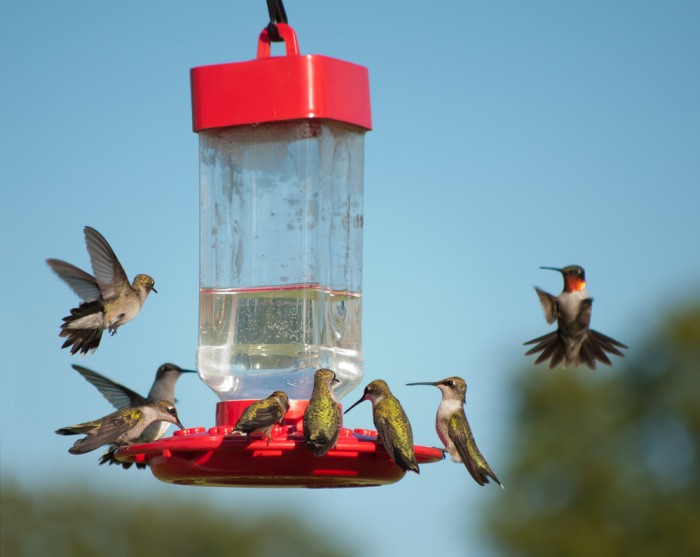
Today, it’s all about how to make Hummingbird Food! In a few easy steps, you can bring those nectar-loving birds directly to your feeders. There is something so exciting to me when I see the first hummingbirds of the season start dropping by my house. A few readers have asked me if I make my own hummingbird food, so with spring coming, I thought I better update this post.
Oh, the joy they bring to my soul! They are so tiny, yet they fly so fast! I strategically placed my two feeders so I could work on my computer and look out the front window right at them.
Do you know how they swoop in and out while guarding their hummingbird food against other birds? In case you missed this post, What You Can Do to Attract Hummingbirds
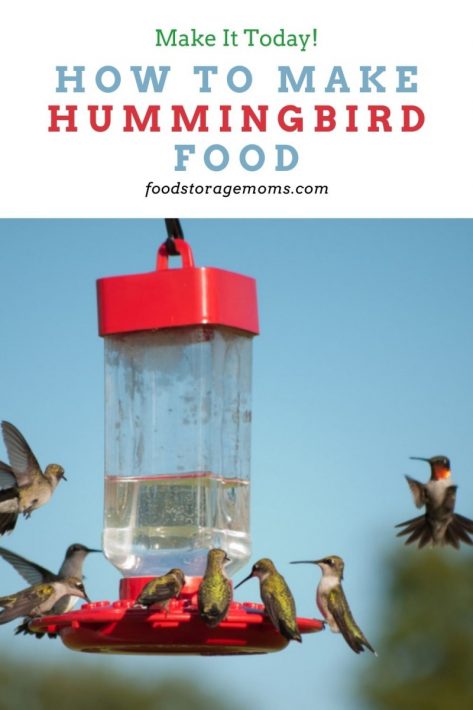
Hummingbird Nest
A few years ago, my next-door neighbor mentioned she had a Hummingbird nest in a tree in her yard and wondered if I had ever seen one.
I said, “No, I haven’t!” I quickly ran over there to see it. We had to look closely because it was super tiny. If you didn’t know it was there, you would never have guessed there was a nest in those little branches.
We didn’t touch it because we knew the mother bird might not return. It was awesome!
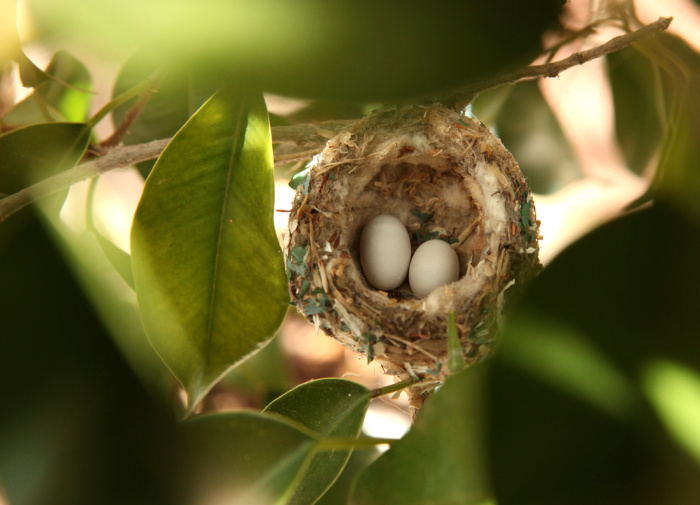
Two Hummingbirds Feeding
I love seeing these little birds feeding on my feeders. It brings me so much joy; I bet you know exactly what I’m talking about.
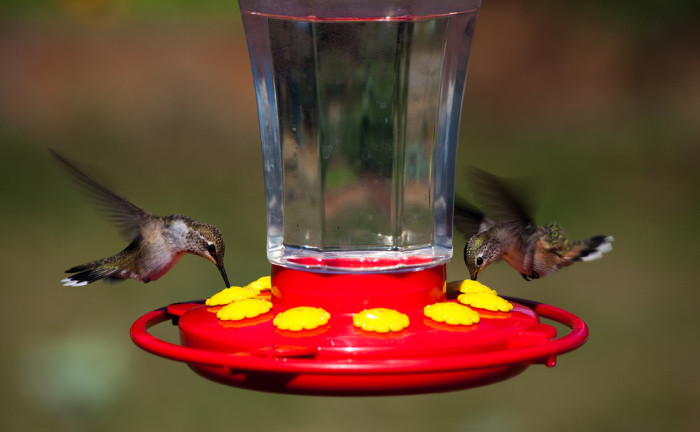
How To Make Hummingbird Food
I made the hummingbird food recipe in printable form because every year, I have to look it up and see the water-to-sugar ratio. Please don’t use distilled water. It’s suggested you use water right out of your tap unless you’re concerned or have your water tested to confirm a high chemical content. Usually, tap water is fine, but if you have filtered water, that would provide an extra level of safety to the birds.
Tap water is okay, but I don’t trust the water system where I live. Even though Mark feels okay about it, I don’t cook or drink tap water in my home. Springwater or reverse osmosis water has been my choice for sugar water. This is typically called nectar. I’m just giving you the heads up here.
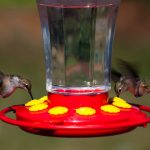
Hummingbird Food Recipe
Ingredients
- 1 cup granulated white cane sugar
- 4 cups water (tap water, unless it has too many chemicals)
Instructions
-
1. Combine the ingredients in a saucepan or bowl. 2. If you want to speed up the sugar dissolving time, heat the water in the saucepan, otherwise, just stir well in the bowl. 3. Make sure the sugar is completely dissolved. 4. You don't need to boil the sugar water unless you feel it has been exposed to bacteria or mold that may be present. 5. If heated, let it cool and fill your clean feeder. 6. Refrigerate any leftover sugar water.
How Often Do I Need To Change The Nectar?
This is where it gets tricky where I live. During the summer months, temperatures are above 90 degrees every day.
From what I’m reading, I should change the feeders each day at that temperature. If you have cooler temperatures, you can go 3-4 days if the temperature is in the 60s, but at least once a week. If it’s really cool, you could possibly stretch it to two weeks.
No matter how often you change the nectar, be sure to clean out the feeder and rinse it with clean water before filling it again. Remember, birds’ beaks can carry microscopic germs and diseases that can infiltrate the feeder and the nectar, so if you’ve seen hummingbirds feed on yours, it just reinforces the idea of cleaning it often.
How Big Are Hummingbirds?
I quote Wikipedia: “Hummingbirds are birds native to the Americas and constitute the biological family Trochilidae. They are among the smallest birds, most species measuring 7.5–13 cm (3–5 in) in length.
The smallest extant bird species is the hummingbird, the 5 cm (2.0 in) bee hummingbird, which weighs less than 2.0 g (0.07 oz).
There is also a species called the giant hummingbird. Although much bigger than the bee species, it’s still tiny compared to other birds you may see in your yard.
Can I Add Red Food Coloring?
It is still up for debate whether red food coloring is safe. I prefer not to add red food coloring to the solution. In years past, some food coloring brands weren’t properly prepared to prevent contamination, so birds would often become sick. Now, the manufacturers do a better job.
Some folks think the red color is needed to attract birds when, in fact, the birds are attracted to the red base or parts in the feeder and don’t need red water. If you are concerned about attracting more birds, place the feeder near very colorful flowering plants or plant them close to the feeder, whichever you prefer to do.
How Do I Know When Hummingbirds Will Return?
Some people aren’t aware that hummingbirds are migratory. That means they spend their winters in the tropics and summers as far north as Alaska. That means you’ll want to use your hummingbird feeder when they tend to be in your area.
Where I live, I put my feeders out about March 1st each year. I want them ready when they return. It will depend on your latitude, altitude, and annual temperatures when they migrate through your area. Following are some guidelines:
- Gulf Coast and southern states = the typical migratory period is February through November.
- Mid-latitudes / central states = The typical migratory period is April through October.
- High-latitudes / northern states and Canada = typical migratory period is May through September.
They are heading north after spending the winter in Central America or Mexico. Once the days get longer and warmer, they will head north.
Will Hummingbirds Return To Our House?
Yes, they will; they have a fantastic memory. But, if the feeders are not out, they will leave and look for another place and may never return. They are loyal but can’t survive without nectar from your feeder or flowing.
Most hummingbirds fly during the day and sleep at night, but it depends; some fly at night.
How Do They Survive The Winter?
When the temperatures get colder, they enter the torpor stage. This helps them preserve their energy for lower temperatures and change their diet to eat more insects when nectar flowers are unavailable.
Some put on heavy coats, and some hibernate (torpor).
Hummingbird Predators
Please hang the feeders at least five feet off the ground so a cat can’t attack them. Praying mantids like to sit on plants and devour the little birds. Who would have guessed this? Not me.
Watch out for frogs, they like to eat them too. Larger birds like Blue Jays and Hawks are a threat as well.
How Long Do Hummingbirds Live?
Their lifespan is usually 3-5 years.
How Do I Clean My Feeder?
This will depend on the type of container you have. I use minimal dishwashing soap and rinse with warm to hot water. I’m always afraid that hot water will break my containers.
Some feeders can be put in the dishwasher. I would read the directions on the one you decide to buy.
How Long Can I Store The Leftover Sugar Water?
To be safe, the limit is two weeks in the refrigerator. I would date the bottle you store it in so you can remember when you made it. Before using the stored nectar, check the container for any discoloring, which may be a sign of mold. If you have any questions about the safety and quality of the nectar, throw it out.
Why Don’t The Hummingbirds Come To My Home?
Stay clear of pesticides and insecticides; they can poison the birds. For one thing, they eliminate insects, one of the food sources the birds need to thrive. Please make sure the sugar water is fresh. As mentioned above, be sure to have some bright-colored flowering plants nearby, too. Some good plants that help attract hummingbirds are bee balm, salvias, weigelas, cardinal, trumpet, and honeysuckle.
They tend to be shy birds, so place the feeder away from areas with a lot of foot traffic or kids playing. Also, they prefer shadier areas, and the shady areas will allow the nectar to last a little longer.
I’ve found my feeders do better if a few trees are around. The hummingbirds like to perch in the trees to rest, and it also provides a location to keep an eye on the feeder. We don’t think of them as predatory birds, but they are territorial birds and will fight to protect “their” feeder.
How do I Keep Pests Away from My Feeder?
If you live in an area that is prone to having a lot of insects, here are a few ideas to help keep them from your feeder and the precious nectar inside:
- Some feeders are better at protecting the nectar, like saucer feeders that keep the nectar away from the feeder “port.”
- Please don’t use a feeder with any yellow color, as it tends to attract bees and wasps.
- Keep feeders clear of tree branches and rain gutters. Consider hanging the feeder with a fish line rather than hooking it directly to the pole. It’s harder for pests to climb the line.
- Most pests like sunlight, so again, put the feeder in a shady area.
- Keep the feeder away from garbage cans and other containers that might attract insects.
- You can try using insect traps, like ant traps, to catch the pests before they can reach the feeder.
Do They Reuse Their Nests?
No, they don’t reuse their nests. Most will barely make it through a single breeding season. They may recycle the sticks and cobwebs from the original nest.
They may even steal another nest and recycle it for their use.
The Best Hummingbird Feeder
I like this one because it’s easier to clean and fill. My neighbor has this style, and when mine no longer works, I will purchase them. I always bring in both feeders, clean them, and refill them simultaneously. Hummingbird Feeder 16 ounces
How To Make Hummingbird Food
Final Word
I hope you print off the Hummingbird Food Recipe to use on another day. Let me know if you have birds visiting your neighborhood. If you have hummingbirds visiting your yard, it’s a good sign that it is full of beautiful flowers that help attract them. Note that if you have large glass windows near your feeder, consider covering them with mesh a few inches from the glass to help protect the birds from flying into the glass and possibly killing them.
Thanks for being prepared for the unexpected. Keep on prepping; you’ll be glad you did. May God bless this world. Linda
Copyright Images: Hummingbirds Hovering On Red Dish Depositphotos_6869090_S By Tamifreed, Hummingbird Eggs In Nest Depositphotos_2160692_S By Tobkatrina, Hummingbirds At Feeder Eating Nectar Depositphotos_71276817_S By Okiepony
The post How To Make Hummingbird Food appeared first on Food Storage Moms.
from Food Storage Moms
No comments:
Post a Comment